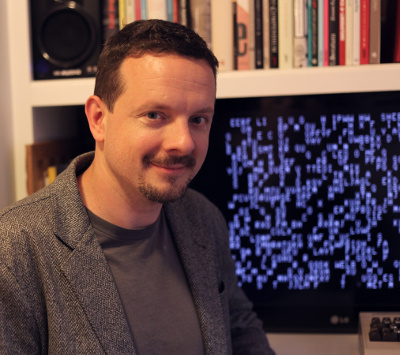Endorsements

Credit: Jonathan Saunders
Brian Moriarty - Professor of Professor of Practice in Game Design at Worcester Polytechnic Institute. Former Senior Game Designer at Lucasfilm Games/LucasArts Entertainment and former Infocom Implementor.
“I never met Bootsie, one of many, many stray cats who shrewdly selected the Crawford ranch, nestled in the hills overlooking San Jose, for pampering.
But I clearly recall Chris’s voice on the phone, softly informing me that Bootsie had lost his jaw. Coyote, probably.
Chris had no choice but to consign his friend to eternity. This is why I do not keep pets.
Trust and Betrayal, published in 1987, immortalized poor Bootsie. Like many of Chris’s games, it explores the problem of communication. How do we reach out to a dying cat, a distant partner, a disloyal friend? How do we bridge the agonizing gap that prevents understanding and forgiveness?
The solutions Chris devised for modeling communication (the inverse parser, thoughts and intentions objectified in icons) were brilliant. But the resulting “game”, abstract, defiantly eclectic, presented a serious marketing challenge. Mindscape took it on anyway. Critics politely noted its innovations. Sales were poor.
Chris inscribed my copy: “Trust no one.” I don’t believe he has ever applied this maxim to himself.
This new project, Siboot, will expose Chris’s ideas to an audience orders of magnitude larger than he could ever hope to reach back in The Day. Perhaps some fearless designer, unborn in 1987, will take what they find here and mold it into a gap-spanning marvel.
Maudlin, to imagine that designer will be Bootsie reincarnate. But I’m of Irish blood, and entitled.”

Janet Murray, Ph.D.
Associate Dean for Research and Faculty Affairs
Ivan Allen College of Liberal Arts
Georgia Institute of Technology
Ivan Allen College Dean's Professor
School of Literature, Communication, and Culture
Director, eTV Lab http://etv.gatech.edu
“Chris Crawford's idiosyncratic experimentation outside established professional and commercial boundaries and his unrelenting focus on advancing the practice of interactive storytelling have inspired aspiring cyberbards for 30 years. I think of him as the Ted Nelson of interactive narrative -- a righteous, obsessive visionary craftsman whose foundational insights and off-center perspective remind us of the unrealized possibilities of the medium. It is exciting to see Chris propose this fully realized specific story to illustrate the power of his dazzlingly ambitious authoring environment. I don't know if I will be enchanted, amused, or annoyed by this particular story on the glorious day when it is released, but I do know that its aspirations will inspire me, and that its completion will be a memorable milestone in the practice of interactive narrative as an art form. Sign me up as a supporter, and GO CHRIS!”

Kate Edwards - Executive Director, International Game Developers Association (IGDA)
“At a time when the game industry continues to heavily focus on technological innovations, it’s critical that we never lose sight of games as a storytelling art form. Even in the IGDA's Developer Satisfaction Survey in 2014, developers cited that “advancement in game design” and “advancement of storytelling” as being two of the most critical factors for the future growth of the games industry. Siboot is an opportunity to do exactly that — to keep advancing game storytelling and narrative.

Rod Humble - game maker, CEO of ChapHat, an arts & entertainment company. Former CEO of Linden Lab (creator of Second Life) and former Executive Vice President of Electronic Arts in charge of the Sims franchise.
“You should attend to this because Siboot matters. Because interactive storytelling, games and art matters. Because Chris Crawford matters.
Interactive storytelling is a big, glorious, still relatively unexplored area of our emerging culture. Siboot and its technology represent a path into new territory. Not the only path, but a unique and original way into this new artistic land.
By backing Siboot you are embarking on an expedition into a new land. I suspect we are going to have a very interesting journey together.”

Kevin Gliner - game designer, Founder and CEO of Flying Car Games. Founding director of the IGDA and former member of the advisory board of the Austin Game Conference. Has developed games for publishers like Microsoft, Activision and Electronic Arts since 1991.
“It would be impossible to overstate Chris Crawford’s impact on our industry. He has spent a lifetime pushing the boundaries of interactive entertainment, and you can see his influence in every modern game today. Siboot is a grand opportunity to join him as he advances the realm of interactive storytelling, no doubt defining the rules we will all be using decades from now.”

Nick Montfort, Associate professor of digital media, Massachusetts Institute of Technology
“Chris Crawford has long been arguing for and working toward compelling interactive storytelling, and Siboot, which engages interiority and communication, promises to be an important milestone on that journey. This is a serious and significant project that deserves our curiosity, our engagement, and our support. I wish that more people were exploring this terrain as provocatively, and were making as many strides.”

Noah Wardrip-Fruin - co-director of the Expressive Intelligence Studio (at UC Santa Cruz) and author of Expressive Processing: Digital Fictions, Computer Games, and Software Studies (from MIT Press).
“Chris Crawford gives us some of the most provocative and insightful thinking about game design and interactive storytelling. I'm in his debt, and probably so are you -- even if you don't realize you are (because you've gotten his ideas second-hand, from people like me). Now it's time to make a payment on that debt. Help support Siboot today!”

Nicolas Szilas - researcher in interactive storytelling since 1999
“Chris’ views on interactive storytelling (IS) have paved the way for much work in the domain, even in worldwide academic research. As the pioneer in the IS he has initiated key concepts such as the interactive storytelling "paradox", the need for complexity, the authoring problem, the abstraction, the iconic user interface for dialogs. By tackling and duly solving the right problems in IS, Chris and his team are creating Siboot - the next landmark in IS… and games.”

Laura J. Mixon is an engineer better known for her science fiction writing, the acclaimed author of six novels and assorted short works. She co-founded Storytron, Inc. with Chris Crawford and spent years working with him on the storytelling aspects of his Storytronics software. In 2015, she is up for a Hugo award for her SFF (science fiction and fantasy) related non-fiction blogging.
“As a long-time storyteller and videogamer, I believe Chris Crawford’s Storytron engine is an exciting, breakthrough technology that has the potential to transform both industries.
For the first time, we have an engine for interactive entertainment that focuses on human emotion and character interaction, instead of just moving around in a virtual environment and handling objects. Storytronics enables the creation of storyworlds that bring storytelling into a whole new medium. Storyworlds give the player a palette of choices that express a much fuller range of actions with the story characters. Love and betrayal—passion and fear—anger and joy. Siboot is just the beginning.
I’m backing Chris Crawford’s interactive storytelling efforts all the way, and you should, too.”

Dave Walker was VP Technology of BrainCo, Computer Scientist at Adobe, and Professor and Dean of the Game and Simulations Programming program at DeVry University, a technical director for Electronic Arts, and has consulted for companies such as ImagiNation Network, MGM Interactive, Viacom New Media, Rocket Science Games, and GE Capital.
“I know there are times when Chris Crawford has felt like Don Quixote and interactive storytelling was his windmill (a.k.a. dragon). He alludes to this in his famous "Dragon Speech" at the 1992 Game Developers Conference. While working with Chris on Erasmatron, (later, Storytron) I learned just how daunting this interactive storytelling dragon was. The inherent conflict between a passive audience for stories with the author in control and the actively engaged audience for games with the player in control made real interactive storytelling appear as illusionary as the mythical dragon.
Fortunately, I learned something even more important from Chris: the dragon can be beaten. The Erasmatron proved it was possible, but also exposed weaknesses in the early design. Storytron dealt with the issues discovered with Erasmatron. There were still rough edges, but the trail had been blazed.
Real interactive storytelling still faces challenges unrelated to technology and beyond the control of the authors of interactive stories. One is audience education. When I first saw 2001: A Space Odyssey in 1968 (in Cinerama) I was blown away by the quality of the film and the incredible plot. Then, 40 years later, I watched it again; this time disturbed by the fact that the plot moved too slowly. The movie industry had evolved from long, slow camera shots and dialog to a succession of quick camera changes and terse dialog, and the audience adapted. If I had watched Indiana Jones in 1968, I probably would have missed a quarter to a third of the movie; the action went by fast and I wouldn’t have been "trained" to follow it. The same issue faces interactive storytelling; the audience will need some training to understand the genre. I believe that Siboot is just the product to provide that training.
It is very appropriate that Siboot is the vehicle that Chris has chosen to showcase his technology. In the three decades he has spent developing Storytron (more than two decades of which it has been the singular focus of his efforts) Chris has left a trail of bread crumbs: Gossip, Excalibur, and Trust & Betrayal: The Legacy of Siboot. Excalibur built on the lessons of Gossip, and Trust & Betrayal built on the lessons of Excalibur. They were ahead of their time, both in concept and in execution. Now the hardware and software are no longer a barrier and the underlying concepts have been refined and enhanced. This time, Siboot won’t be a promise of things to come, it will be the promise fulfilled.”

Jonathan Bayrek-Lev - iOS Developer and Indie Game Designer
“Fair disclosure: over half a decade ago I worked with Chris Crawford on the technology that would become Siboot. This puts me at a uniquely qualified position to endorse his work, for although I will receive absolutely no personal benefit from the success of Siboot, I am quite familiar with both the technology and the man behind it.
I will be investing money into Siboot, and you should invest in it, too. If you’re not sure why, I’ve got a story to tell you.
If you’re still reading, perhaps you’re not too familiar with Chris Crawford. He is one of the sages of game design, of the same vintage and calibre of the likes of Sid Meyer and Will Wright. In the 80s he proved himself among the luminaries of computer strategy game design with masterpieces such as Eastern Front (1941) and Balance of Power, the latter still unmatched to this day in its sweeping, realistic portrayal of Cold War geopolitics. His contributions to the culture of game design have also been immense, for instance his book The Art of Computer Game Design, the great classic of the field, or the fact that he lead the founding of the GDC. He invented the scrolling map, the most fundamental UI element of most strategy games, for Chrissakes!
So, if he’s so important, why am I having to tell you who he is? The thing is, Chris opted out of the games industry around the turn of the 90s. Whereas, for example, his colleagues Meyer and Wright were content with evolving the form, producing increasingly sizeable, complex and refined 4X strategy games and software toys, respectively, Chris was gunning for a revolution so big he felt it could only be achieved from outside the mainstream. He went indie at a time when game development was becoming increasingly centralised under giants such as EA, and he paid the price in his career, and in my needing to write this.
What vision did Chris have that was worth so much? The best way to explain it, I think, is by analogy to the fictional Star Trek technology of the Holodeck. The Holodeck, in case you’ve been living under a rock, is a room which can create a 100% accurate, multi-sensory simulation of any environment the user desires. It is virtual reality taken to its logical conclusion of total immersion. But the holodeck isn’t just an accurate sensory simulation - it also simulates people with uncanny accuracy, people who behave, emote and communicate with such realism that they can form friendships, romances and rivalries with the Holodeck’s users, and even occasionally stage mutinies or plot escapes from the Holodeck to take control of the spaceship that houses it.
It’s fair to say that most computer game designers hold out the Holodeck as an ideal to aspire to in their games. But they differ greatly in the properties of the Holodeck that they emphasize. In recent decades, the games industry has attempted to compete with the Holodeck’s sensory realism. It has made astonishing advances in graphics, sound, and the size and complexity of the worlds the player can explore. What has scarcely even been attempted is to recreate the holodeck’s ability to simulate people. It’s difficult for someone like me, who grew up on 8 Bit graphics, to believe just how far computer game visuals have advanced, but in terms of the characters that inhabit these magnificent virtual worlds, I see no great advance over the games I played as a child.
It is this great untapped potential of computer games that Chris has explored for the better part of his life. His first major attempt was the original Siboot, published in 1987. It was so far ahead of its time it wasn’t even funny. Whereas most games centered on violent conflict, Siboot focused on interpersonal conflict. You had to form friendships, handle rivalries, trade gossip, sell people out, and generally connive, butter up, backstab and smooth-talk your way to victory. Even by today’s standards, the original Siboot is a state-of-the-art game of social intrigue. Had it been a commercial success, there’s no telling how today’s games industry would look like - it certainly would have offered a much broader output, with many games exploring various aspects of human behavior and experience that, as things turned out, remain uncharted territory.
But Siboot failed, both because it wasn’t good enough and because the public wasn’t ready. It wasn’t good enough because the interpersonal interactions were too simplistic, too mechanical. They lacked sufficient nuance and emotional depth to be interesting. The public wasn’t ready because most people weren’t playing computer games, and the ones who were tended to be hardcore gamers interested in more and better games of the same types, rather than a completely new type of game.
During my years working with Chris, I have seen the great effort and care he has put into outdoing that first, noble failure. The technology he has now is, without exaggeration, a hundredfold more sophisticated than the original Siboot drama engine. In the right hands, it can be used to create fabulous virtual characters exhibiting virtually any kind of personality, motivation or emotion. For this new remake of Siboot, Chris is using only a fraction of that power, but we can still expect a much richer and more engaging product this time around. As importantly, Chris is developing a vastly improved audiovisual experience for this Siboot, including a charming dark comic book graphics style and, most exciting of all, a system for dynamically animating the facial expressions of all the different characters to indicate their fluctuating emotions, moods and intents. This is a game where you actually need to look virtual people in the eye and try to figure out their emotional responses to your in-game actions - how cool is that?
The market, I think, is also much more ready for Chris’ work now than it was back then. Digital games in various forms have permeated our culture so widely that most people enjoy them to some extent (especially seeing as how mobile phones, owned by almost everyone, are de facto gaming devices). Even among hardcore gamers, the rise of the indie developers shows that there is interest in the new and the unconventional. Conditions have ripened for Chris’ vision to get the following it deserves.
Beyond my high expectations for Siboot itself, I have another reason to invest in this project. Chris’ long term goal is to release his technology for free use by the general public, eventually open sourcing the code itself. I know Chris personally, and I know his motives are idealistic and altruistic. He wants this technology to succeed because he believes all of us deserve it too, all of us deserve to enjoy the immense potential of gaming enhanced by interaction with deep and sophisticated virtual humans. That is a goal worth my money and yours, and with our help no one is in a better position to realise it than Chris Crawford.”

Christy Dena,
Director, Universe Creation 101
Senior Lecturer, Games, SAE Creative Media Institute
Professor Adjunct, Research Office, Creative Industries, Queensland University of Technology
“A common claim about games is that they work with systems, and that reality is full of systems. But we often see games reproduce constructions of unaware views of the world. Views that don't scratch the surface of who we are and can be. Siboot is a game that draws on what I find most intriguing about the possibility of games: raising the bar for human understanding. Siboot's skill requirement doesn't rely on input device dexterity, or canny readings of game system prompts. Instead, it requires the player to draw on how they really (if they're conscious) understand and respond to the world. I am excited by what Siboot develops: a truer experience of the self in a game, and a system that strives to replicate and transform how we interact with others. As someone who has a background in performance, Siboot reminds me of the internal work I had to do to understand myself to be truly in-the-moment and available. I believe just playing Siboot, and working with the Storyworld Authoring Tool will spark new ideas for game makers.”

Patrick Dugan - cryptocurrency systems designer
“Chris Crawford has returned from 24 years in the desert with stone tablets on which iconic representations of verbal concepts are transformed into gameplay. Getting involved with Storytron was a huge watershed in my early career at age 19, and my position in those debates was that the structure of the system should be embedded in graphically friendly, wet, game-like set-ups. With the post-Storytron reimagining of Siboot, he's refined his life's work into something accessible for a mainstream audience. We applaud Miyazaki's last work or Jorowdowsky Kickstarting a biopic at age 86 — here we have that for game design, with the added bonus of setting a benchmark for a whole new genre.”


